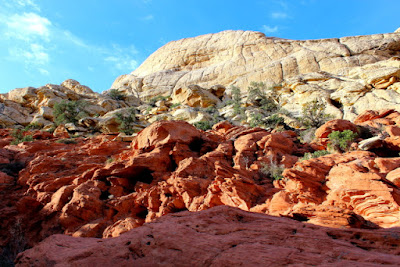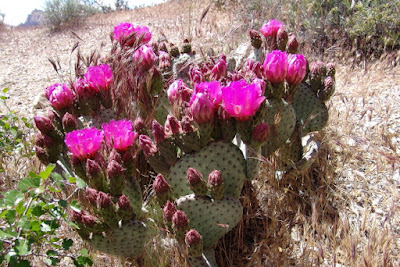 |
| Panoramic Picture by Kolohe |
 |
| Panoramic Picture by Kolohe |
In 1905 the Excelsior Stone Quarry opened and became one of the first commercial industries in the Las Vegas area. Giant block of high-quality sandstone, some weighing as much as 10 tons, were quarried using channeling-traction equipment and loaded onto wagons that were pulled into Las Vegas with a 17-ton steam engine known as the "Big Devil." The large sandstone blocks were then shipped by rail to Los Angeles and San Francisco where the material was used for decorative building facades. Because the production and shipping costs were so high, and other similar sandstone deposits were located closer to a rail line, the mine closed in less than a year. The mine was later reopened by another mining company; but it too went out of business, leaving a number of quarried blocks still at the site.
 |
| Picture by Kolohe |
Shortly after passing through the sandstone quarry, the trail splits with one trail going to Calico Tanks and the other trail going to Turtlehead Peak. Just east of the junction there is a very well preserved historic Agave Roasting Pit that was used by early Indian tribes that lived in the area.
After passing the Agave Roasting Pit the trail then continues up a very picturesque canyon to Calico Tanks. During the hotter months of the year it is advisable to hike this trail in the morning because the trail is in the shade almost all of the way to the tanks.
 |
| Picture by Kolohe |
 |
| Picture by Kolohe |
 |
| Picture by Kolohe |
When we arrived at the Tanks, we were surprised that the water level was quite low for spring conditions; but it still provided some nice pictures.
 |
| Picture by Kolohe |
 |
| Picture by Kolohe |
Attached are some additional pictures from several years ago when we had a wetter winter. The Tanks were filled with more water and there were more wildflowers along the way.
BONUS HISTORICAL PICTURES
Grandpa didn't ever have any formal music training, but he learned to play the fiddle (violin) on his own. He met a young school teacher, my Grandmother Elizabeth Mahala Bates, who had graduated from normal school and also just happened to play the piano. (Normal school trained high school graduates "to be teachers by educating them in the norms of pedagogy and curriculum.") Because of their musical talents they often played for Saturday night barn dances. One of the favorite songs they played was "Turkey In The Straw." In later years we even had a record of the song.
After my Grandparents passed away, Jepson's old violin was found in the basement of their house. His son Ormel kept the violin for a number of years, but did not ever use it. He eventually gave the violin to my brother Merl because Merl played the piano and had some musical talent. Merl kept the violin for a number of years, but he also did not ever use it.
Our daughter Heather started taking Suzuki violin lessons when she was about five years old and has played the violin since that time, so Merl gave her the violin. By this time the instrument had completely fallen apart from age and neglect, so Heather contacted a craftsman that restored old violins to see if it would be possible to even restore the instrument to playable condition and how much it would cost.
The craftsman was really interested in the violin and after examining it he wanted to know more about the instrument's history. It was his opinion that the violin was probably hand crafted sometime in the 1800s in Japan, or in that general area of the world, using a combination of different woods, some of which he had never seen before. He wanted to know how the violin ended up in Kansas in the late 1800s. Unfortunately, we will probably never know the answer to that question.
The craftsman said it would be a lengthy, expensive project to restore the violin, but the value of the violin when restored would probably be more than the restoration costs. Heather made the decision to have the violin restored and after the restoration was completed the violin looked like new. Heather then played the violin for us so that we could listen to how it sounded. I know very little about music; but I did recognize that the violin had a beautiful tone that was different than the tone from the violin that Heather has played for a number of years. We were told that the different tone is probably a function of the wood and handcrafted design.
Sophia, Heather's daughter, is now taking guitar lessons, so maybe someday she will play the same violin that her Great-Great-Grandfather played!


















































No comments:
Post a Comment